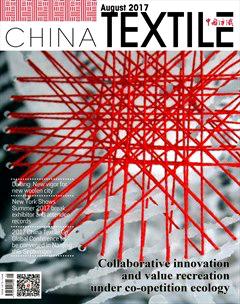VDMA:Machinery and textiles for a better future
By+Flora+Zhao
On the occasion of its 125th anniversary, the VDMA has put together a series of multimedia reports. Published on the new website https://humans-machines-progress.com the reports show: Machines are not an end in itself for the machinery engineering industry. Regina Brückner, Vice-Chairperson of the VDMA Textile Machinery Association and Managing Associate of Brückner Trockentechnik, explains:“Machines are the means to make progress come true for people and to meet challenges like energy, mobility, infrastructure and health. Textiles and textile machinery play – sometimes hidden – a major role in improving daily life.”
Textile machinery is, for example, a starting point for resourceefficient construction. Lightweight construction materials based on knitted, woven or nonwovens fabrics enable enormous savings potential in aerospace. 1,974 litres of kerosene can be saved per aircraft per year with 20 kilograms less weight on the A320.
Infrastructure maintenance is currently time consuming and costly because the reinforced concrete that has been used in many structures, contains steel reinforcing bar that can corrode, making the concrete structure crack. Textiles offer a robust alternative by replacing steel with carbon. Carbon concrete is durable and versatile in its uses. The carbon used to reinforce concrete is even stronger than steel, but at the same time much lighter and more durable since it does not corrode. Building elements made of carbon concrete can thus be thinner, reducing demand for raw materials and, as a result, energy use and CO2 emissions are cut almost by half. These materials that help maintaining bridges and buildings are made on warp knitting machines, where yarn is processed into net-like cores or even three-dimensional spacer fabrics.
In medical technology, textiles play a vital part, too. The use of textile-based implants, such as stents, heart valve replacements and artificial cartilages or tissues, is growing strongly in modern surgical techniques. Garments with integrated sensors are already commercially available, including T-shirts that can measure pulse, breathing and body movement.
In the working world, textiles are both ubiquitous and practically invisible: Even in modern production sites, workers need professional and protective clothing to protect them from injury and safeguard against hazardous environments. Air conditioning is meanwhile becoming widespread in the modern working world – even in regions with no weather extremes. Air and dust filters made of nonwovens are most of the time not visible but they are there and help to protect staff, as well as sensitive equipment, in production plants.endprint
The stories Materials and Health on humansmachines-progress.com show more exciting examples of mechanical and plant engineering being the driving force for lightweight construction and how medical textile technology ensures good health and quality of life.
Successful Textile Machinery Symposium in Colombia
In July, seven VDMA member companies presented their technologies to the representatives of the Colombian textile industry. More than 100 Colombian textile manufacturers used the symposia in Bogotá und Medellín as an opportunity to gain first-hand information about German Technology.
The VDMA member companies Trützschler, GrozBeckert, AUTEFA Solutions Germany, Brückner Trockentechnik, Mahlo, Interspare and Saueressig participated in the business delegation trip organised by the GermanColombian Chamber of Commerce (AHK) and actively supported by the VDMA. All the companies could establish contacts with potential customers and representations and even partially conclude orders.
Furthermore, the visits to the two large multi-level textile manufacturers Artextil (design, textile printing, finishing) and FABRICATO (spinning, weaving preparation, weaving, finishing) provided insights on the state of the Colombian textile and apparel sector.
Currently, the Colombian textile industry employs 114,322 people, contributing 6.5 per cent to the gross domestic product of the country. In addition to the import surplus of almost USD 1.2 billion, the Colombian textile and apparel sector is struggling primarily against illegal imports from Asia, which are countered by the government. The import of textile raw materials should be reduced through local production with the goal to increase quality, productivity and ultimately also export. In 2016, the export ratio was a mere 15 per cent. The security situation in the country has improved in recent years.
Strong German participation at Irantex
26 VDMA member companies will participate in the official German presentation at Irantex, taking place beginning of September in Tehran. The German Pavilion, initiated by the VDMA Textile Machinery, will cover 300 square meters of exhibition space. It is the first time that the German Federal Ministry for Economic Affairs and Energy (BMWi), in cooperation with the Association of the German Trade Fair Industry (AUMA), is supporting a German group participation at Irantex.
The prospects for German textile machinery in Iran are promising. In the first five months of 2017, Germanys exports of textile machinery and accessories reached more than 27 million euros which was already more than in the entire year 2016.
The VDMA exhibitors at Irantex will cover the whole textile chain
ANDRITZ Küsters, Autefa Solutions Germany, Brückner Textile Technologies, Dilo Maschinenfabrik, Genkinger, Heusch, Interspare, Jagenberg Textile, Karl Mayer Textilmaschinenfabrik, Karl Mayer Technische Textilien, Küsters Calico Machinery, A. Monforts Textilmaschinen, Neuenhauser Maschinenbau, NOMACO, Oerlikon Manmade Fibers Segment c/o Oerlikon Textile, Georg Sahm, Sohler-Neuenhauser, Spinnbau, Strobel Spezialmaschinen, Temafa Maschinenfabrik, Textechno, Trützschler, Weko - Weitmann & Konrad, Welker Vacuum, Xetma Vollenweider, ZSK Stickmaschinen.endprint
- China Textile的其它文章
- Dear readers
- Collaborative innovation and value recreation under co-opetition ecology
- Dalang New vigor for new woolen city
- NUOYI Technology+Ideas+Talents make the extraordinary
- EcoChic Design Award 2017 finalists photoshoot
- New York Shows Summer 2017 break exhibitor and attendee records

